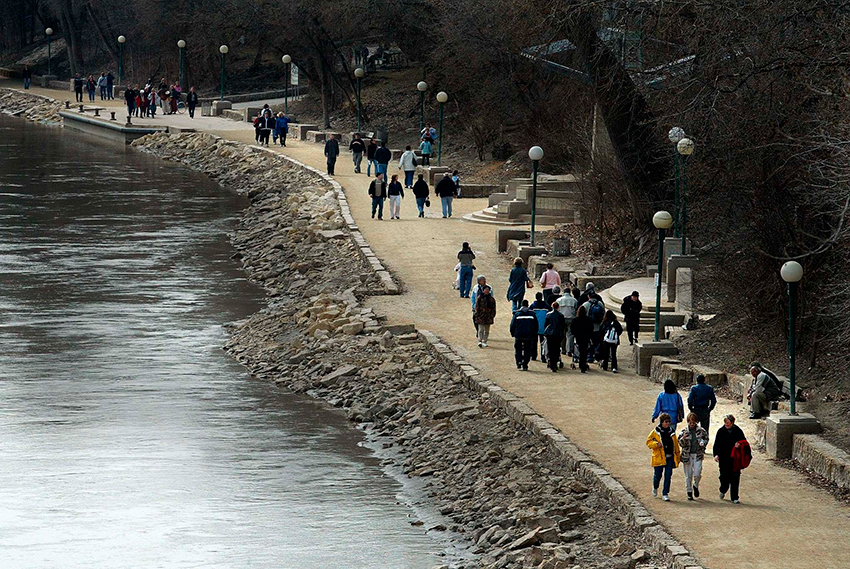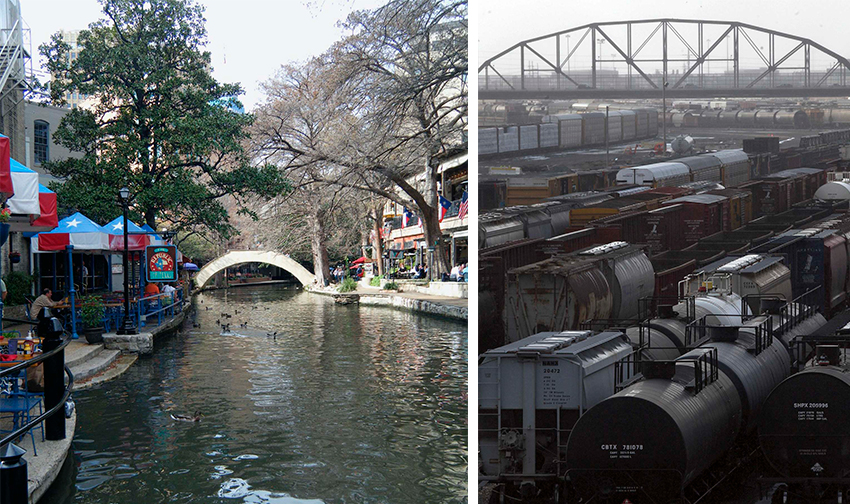
By Brent Bellamy, Creative Director and Architect
Republished with permission courtesy of the Winnipeg Free Press.
Makes no sense to dismiss rail relocation, riverwalk protection without knowing costs, benefits
There is always a reason not to be bold. There are always other priorities. It is always easier to continue doing what you know.
What has made most of the world’s great cities great is the ability to embrace a vision for the future and demonstrate the courage to make choices that challenge the status quo. Image: Ken Gigliotti / Winnipeg Free Press Files
Image: Ken Gigliotti / Winnipeg Free Press Files
Manitoba’s PC government recently passed on two opportunities to lead a courageous dialogue about the long-term vision for our city. By cancelling the study into rail relocation and deciding not to further investigate a report on the use of the floodway to control summer river levels in the city, the opportunity for informed public debate was lost.
When hearing the words rail relocation, most Winnipeggers instinctively roll their eyes and say it’s a prohibitively expensive dream that could never happen.
Without a study, however, the circular debate is based on speculation, not information. The province did not cancel rail relocation. It cancelled the opportunity to make informed decisions about the future of railways in our city.
With underpasses or bridges at Waverley Street, McPhillips Street, Jubilee Avenue, Chevrier Boulevard and Marion Avenue all on the planning board, as well as a replacement of the Arlington Street Bridge by 2020, there is more than $1 billion in projects in the queue addressing the railways.
It would seem prudent to consider all options before finalizing such significant taxpayer expenditures. The time to gather the information and make informed decisions on how we spend our money is now. Image: (Left) Judith Evans/St. Louis Post-Dispatch/MCT
Image: (Left) Judith Evans/St. Louis Post-Dispatch/MCT
The Riverwalk winds through about 5 miles of San Antonio. The central portion is lined with restaurants and shops, and river taxis offer a convenient way to reach museums, a mall and other attractions.
(Right) Phil Hossack / Winnipeg Free Press files
Compounding these expenses, new regulations will soon take effect in response to the Lac-Mégantic, Que., disaster and an expected 1,000 per cent increase in the transport of crude oil by rail in Canada from 2012 to 2018. Extensive new buffer zones and requirements for concrete crash walls and berms mean railways will have an even greater presence and effect on the form of our city in the future.
A 2007 study done in Denver considered relocation of a similar scale rail line and yard found in Winnipeg. It identified a capital cost of $1.2 billion, but made the significant point that while building bridges is a pure cost, relocation is an investment with a payback to the economy and quality of life in a city. The study concluded job creation, an increased tax base through significant infill development, reconnection of inner-city communities and reusing lines as transit and bike corridors would add $5 billion to Colorado’s economy.
With these conclusions, it seems a study of Winnipeg’s condition might provide valuable information about the best way to spend our tax dollars and improve the city’s urban quality.
It is also important to recognize looking at the future of railways is not an all-or-nothing proposal. A comprehensive study might find low-cost moves that have high impact.
Maybe moving lines, but not yards, is possible. Maybe combining both yards into one (as suggested in the Denver study) is possible. Maybe moving it all is possible. Good decisions are based on good information — what are the true economic and social effects and what are the opportunities? By cancelling the study, our ability to define priorities through informed public debate has been lost.
A similar argument can be made for the decision to not pursue further study and dialogue about use of the floodway to control river levels in the city during summer months.
A recently submitted provincial advisory committee report recommended against summer use, stressing it was not because it wasn’t seen a good idea but because the discussion is so politically polarizing. The opportunity is being missed to respond to this realization and use the comprehensive study to open an informed public debate about the long-term prospects and constraints of the proposal.
The scenario is often reduced to an image of the city flooding property of rural residents so Winnipeggers can walk their dog on the river walk at The Forks. The reality is more complex and the impact much further-reaching.
The waterfront is the most valuable and highly sought after real estate in almost every city, but in Winnipeg, river levels fluctuating by up to five metres in a year has meant this land is often ignored or relegated to parking lots and industrial uses. The river walk is always a lightning rod because it is one of the few locations where we actually interact with our rivers. They are a significantly underused recreational and development amenity. Because of this, regulating the levels could completely redefine the character of our city.
With more than 240 kilometres of waterfront in Winnipeg, winding through almost every neighbourhood, making the riverbanks accessible would breathe new life and economic growth into existing communities across the city. Consistency of water levels would unlock the potential of the waterfront, attracting development, increasing land values and growing the tax base, turning it from being Winnipeg’s backyard into its front yard.
Regulating river levels has other critical economic benefits to the city. It is by far the most economical way to reduce pressure on Winnipeg’s combined storm-sewer system that threatens basement flooding and pumps an average of 900 million litres of sewage directly into the rivers annually. A complete sewer separation would cost approximately $4 billion.
The fluctuating river also means the city spends $2 million each year to stabilize riverbanks. City engineers have identified a $200-million backlog of critical riverbank-stabilization projects. Regulating river levels would reduce erosion within the city and likely mean a significant cost savings in the long term.
There are economic, social, environmental and ecological complexities outside the city that would have to be studied and overcome before the floodway could be used consistently. Some upstream properties are affected, and it may cause some riverbank erosion, but with more information, early engagement and inclusive dialogue, a viable solution could likely be found. By breaking down the urban-vs.-rural divide and having collaborative discussion, the benefits could be shared by all.
The floodway has been used in the spring 31 of the 48 years since it was constructed, and over the last 15 years it has been used six times in the summer months. This frequency has significantly restricted the viability of properties affected by upstream flooding.
A 2003 engineering report indicated buying these properties could cost up to $10 million. This number has certainly increased, but with the benefits identified and considering that when the floodway is used in the summer today, landowners receive compensation totalling as much as $1 million in a year, it may be prudent to investigate new ways forward. This can only be achieved by understanding the possibilities and engaging in educated discussion.
Visionary ideas and the courage to implement them only come through inclusive public dialogue. It is too easy to say we can’t afford to think big or we have more immediate priorities. To make prudent decisions and move the city forward, it’s important our governments not dismiss opportunities such as the railway and floodway studies, but instead take the lead in facilitating an educated discussion about the vision we have for the future of our city.
Brent Bellamy is creative director at Number Ten Architectural Group.
bbellamy@numberten.com